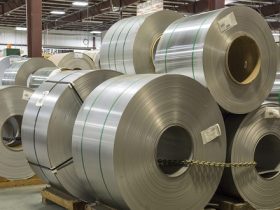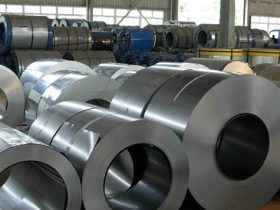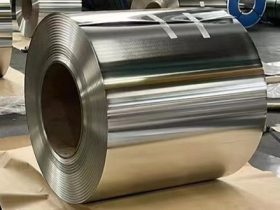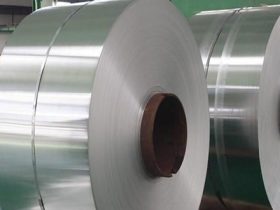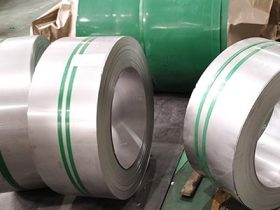Grade: 316 (ASTM A240/EN 10088)
Thickness: 0.3–6.0mm (customizable)
Width: 600–1800mm (customizable)
Surface Finish: 2B, BA, Mirror, Etched, No. 4 Polish, etc.
Tensile Strength: ≥515 MPa
Elongation: ≥40%
| Parameter | Details |
|---|---|
| Material Grade | 316 (ASTM A240/EN 10088) |
| Thickness Range | 0.3 – 6.0 mm (customizable) |
| Width Range | 100 mm – 1500 mm (customizable) |
| Surface Finish | 2B (Bright Annealed), No. 4 (Polished), etc. |
| Tensile Strength | ≥ 515 MPa (min) |
| Elongation | ≥40% |
| Yield Strength | ≥ 205 MPa (min) |
| Chemical Composition | Chromium (Cr): 16.0% – 18.5%; Nickel (Ni): 10.0% – 14.0%; Molybdenum (Mo): 2.0% – 3.0%; Iron (Fe): Balance; |
Composition of 316 Stainless Steel Coil
Based on its composition, 316 stainless steel coil are categorized into four main types: 316, 316L, 316H, and 316Ti. However, 316H and 316Ti are generally used for pipe and sheet production. For coils, the two main types are 316 and 316L. Below is the chemical composition:
-
316 Stainless Steel Coil: Essentially, 316 stainless steel coils have a composition similar to that of 304 stainless steel. However, it is enhanced with the addition of molybdenum, which provides superior pitting corrosion resistance. At high temperatures, 316 coils ensure exceptional durability and are commonly used in the production of chemical equipment and dyes.
-
316L Stainless Steel Coil: The main components include carbon, manganese, phosphorus, and sulfur. 316L coils have a lower carbon content compared to 316. The standout feature of 316L coils is their superior electrochemical corrosion resistance.
Surface Finish of 316 Stainless Steel Coil
Not only 316 stainless steel coil, but most metals and alloys are classified based on their surface brightness. The international standards for surface brightness are used to compare and differentiate between types. 316 stainless steel coil come in various levels of brightness, gloss, roughness, and discoloration. The surface finish also plays a key role in determining the price of the stainless steel coil.
-
316 Stainless Steel Coil 2B: This type has a significantly smoother surface compared to many other stainless steel coil. Not only does it enhance the aesthetic appeal of the surface, but the 2B finish also improves the mechanical properties of the product.
-
316 Stainless Steel Coil BA: The BA (Bright Annealed) coil is highly polished, often compared to a mirror finish. The BA polishing process involves two sequential steps: cold rolling and annealing.
-
316 Stainless Steel Coil No.1: The No.1 finish is produced first in the sequence of coil polishing processes. The surface of No.1 stainless steel coil is slightly white and dull, offering a rough texture.
-
316 Stainless Steel Coil No.4: This type of coil has a distinct polished finish. The polishing is done using abrasive pads or, more commonly, by applying chemicals to grind the stainless steel surface. No.4 finish is part of the high-gloss group, offering superior brightness.
316 Stainless Steel Coil Sizes
316 stainless steel coil come in various standard sizes, as well as customizable sizes based on specific requirements. To make transportation easier, manufacturers often slit coils into smaller sizes to reduce volume. The thickness of the coil remains unchanged when it is slit. Below are the commonly seen sizes for 316 coils:
316 Stainless Steel Coil Thickness
As a coil product, 316 stainless steel is typically cold-rolled to achieve a thin gauge. The maximum thickness for 316 coils is 12mm, though the most common thicknesses are between 2mm and 6mm. Compared to regular 316 coils, 316L is thicker. The thickness of the coil can also vary depending on its origin and specific manufacturing process.
-
-
0.1 – 1mm
-
2mm
-
3mm
-
5mm
-
6mm
-
8mm
-
10mm
-
316 Stainless Steel Coil Width
The maximum width achievable for 316L coils is 2000mm. 316 stainless steel coil are typically narrower, with widths ranging from 914mm to 1500mm. The width of each coil significantly impacts the shipping and packaging process.
-
-
1000mm
-
1220mm
-
1500mm
-
1550mm
-
2000mm
-
316 Stainless Steel Coil Length
-
-
1000mm
-
2000mm
-
2440mm
-
6000mm
-
316 Stainless Steel Coil Weight
There is no fixed weight for a 316 stainless steel coil. It must be calculated based on a formula. The specific gravity of 316 (L) is 0.00798 gr/mm³. Thus, the weight can be calculated using the following formula:
Weight = Width x Length x Thickness x 0.00798
However, results may have minor deviations, which are acceptable as long as they fall within permissible limits and do not affect the manufacturing process.
| Comparison Items | 200 Series (201) | 300 Series (304 as a representative) | 400 Series (430 as a representative) |
|---|---|---|---|
| Chemical Composition | Chromium (Cr) 16% – 18%, manganese (Mn) 5.5% – 7.5%, nickel (Ni) 3.5% – 5.5%, nitrogen (N) ≤0.25% | Chromium (Cr) 18% – 20%, nickel (Ni) 8% – 10.5%, low carbon | Chromium (Cr) 16% – 18%, low carbon, ferrite structure |
| Tensile Strength (MPa) | ≥520 | ≥515 | ≥450 |
| Elongation (%) | ≥40 | ≥40 | ≥22 |
| Corrosion Resistance | Moderate corrosion resistance, suitable for less corrosive environments. Prone to rusting in humid or corrosive conditions compared to 300 series. | Good general corrosion resistance, suitable for general atmosphere, fresh water and other environments, relatively weak tolerance to chloride ions | Fair corrosion resistance, better than carbon steel but inferior to 300 series. Susceptible to pitting corrosion in chloride-rich environments. |
| Magnetic Properties | Weakly magnetic due to its alloy composition | Non-magnetic in the annealed state, may become slightly magnetic under certain processing conditions | Magnetic |
| Cost | Relatively low, due to lower nickel content and relatively simple composition | Moderate, as a widely used and reliable grade | Relatively low, similar to 200 series in terms of cost, but with different performance characteristics |
| Application Fields | Interior decoration, low-end kitchenware, some decorative trims in buildings where corrosion resistance requirements are not high | Kitchen utensils, building decoration, general industrial components and other daily fields | Appliance housings, automotive trim, some food processing equipment where non-magnetic properties are not required and moderate corrosion resistance suffices |



